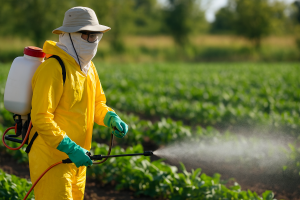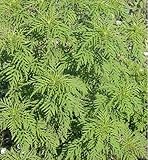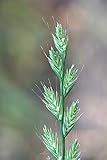Weed resistance to herbicides like glufosinate is a growing concern for farmers and land managers. Glufosinate, a broad-spectrum herbicide, has been widely used to control various types of vegetation. However, overuse has led to the emergence of resistant weed species that threaten agricultural productivity.
Glufosinate resistant weeds continue to spread across regions and prove difficult to manage even with increased chemical use.
Understanding which weeds have developed resistance to glufosinate is critical for devising alternative weed management strategies.
This article highlights the top 10 most problematic weeds resistant to glufosinate, backed by scientific evidence and field reports. We will explore each weed in detail, including its growth characteristics, resistance profile, and practical implications.
What Weeds Are Resistant To Glufosinate? A Complete Guide
1. Palmer Amaranth
Palmer Amaranth has rapidly developed resistance to several herbicides, including glufosinate. It thrives in hot climates and grows aggressively, often outcompeting crops for nutrients. Its adaptability makes it a serious threat in agricultural zones across the U.S.
This weed can grow several inches per day and produce hundreds of thousands of seeds. Its genetic diversity contributes to its ability to resist control measures over time. Palmer Amaranth often appears in soybean, cotton, and corn fields.
Controlling Palmer Amaranth with glufosinate has become increasingly ineffective. Alternative methods like crop rotation and mechanical control are recommended. Farmers must act quickly to prevent this weed from spreading.
- Pros:
- Fast-growing
- High seed output
- Heat tolerant
- Competitive growth
- Genetic diversity
- Survives drought
- Adapts quickly
- Cons:
- Herbicide-resistant
- Labor intensive
- Crop competition
2. Waterhemp
Waterhemp is a summer annual broadleaf weed with documented resistance to glufosinate. It is particularly problematic in corn and soybean-producing areas. This weed is hard to identify early because it closely resembles other Amaranthus species.
Waterhemp produces large numbers of seeds and has an extended germination window. This makes it hard to manage with a single herbicide application. Its rapid growth and adaptability further contribute to its persistence.
Resistance to glufosinate in Waterhemp has been confirmed in several U.S. states. A diversified management strategy is crucial to keep its populations in check. Tillage and herbicide rotation can help slow its spread.
- Pros:
- High seed count
- Grows rapidly
- Spreads widely
- Difficult to spot
- Adapts easily
- Survives drought
- Long germination
- Cons:
- Hard to control
- Resistant strain
- Early misidentification
3. Giant Ragweed
Giant Ragweed is a broadleaf weed that competes aggressively with crops for light and nutrients. Its resistance to glufosinate has been documented in various agricultural areas. This weed is most common in the Midwest and Eastern United States.
The plant can reach up to 15 feet tall, making it one of the tallest and most obstructive weeds in crop fields. Its extensive root system allows it to absorb more nutrients than surrounding plants. It also causes allergic reactions in humans due to its pollen.
Giant Ragweed’s resistance to glufosinate has reduced the effectiveness of many control programs. Farmers often need to implement mechanical or cultural practices to contain it. Delayed planting and cover crops are alternative management strategies.
- Pros:
- Tall structure
- Nutrient absorbent
- Wide root base
- Known allergen
- Competes heavily
- Early emergence
- Wide distribution
- Cons:
- Glufosinate-resistant
- High pollen count
- Reduces yield
4. Horseweed (Marestail)
Horseweed, also known as marestail, is increasingly resistant to glufosinate and other herbicides. It can grow in both agricultural and non-crop environments, thriving under a variety of conditions. This adaptability makes it difficult to control.
It is known for its fluffy seed heads that can disperse widely through wind. These seeds remain viable in the soil for years, complicating control efforts. Horseweed can germinate in both fall and spring, extending its lifecycle.
Glufosinate-resistant populations are now common in many states. Tillage, planting cover crops, and using multiple herbicide modes of action are vital. Delayed planting may also reduce its impact.
- Pros:
- Spreads easily
- Grows anywhere
- Soil seed bank
- Wind dispersal
- Bi-seasonal germination
- Low water need
- Thrives in stress
- Cons:
- Resistance spread
- Persistent growth
- Control costly
5. Italian Ryegrass
Italian Ryegrass is a winter annual grass that has shown resistance to glufosinate in several farming areas. It germinates quickly and competes strongly with winter crops like wheat and barley. This weed is difficult to control once it establishes itself.
is a winter annual grass that has shown resistance to glufosinate in several farming areas. It germinates quickly and competes strongly with winter crops like wheat and barley. This weed is difficult to control once it establishes itself.
Italian Ryegrass has a high tillering capacity, allowing it to produce multiple shoots. It thrives in moist, fertile soils and can be mistaken for other grasses. Its resistance has been documented in multiple countries.
Managing this weed requires both chemical and non-chemical strategies. Crop rotation and delayed seeding are effective. Pre-emergent herbicides may also offer control if used timely.
- Pros:
- Dense growth
- High tillering
- Moisture-loving
- Early emergence
- Rapid spread
- Soil coverage
- Tolerates cold
- Cons:
- Herbicide-resistant
- Labor-intensive
- Reduced crop yield
6. Johnsongrass
Johnsongrass is a perennial weed resistant to multiple herbicides, including glufosinate. It spreads both through seeds and rhizomes, making it particularly persistent. This weed is especially troublesome in the southern U.S.
is a perennial weed resistant to multiple herbicides, including glufosinate. It spreads both through seeds and rhizomes, making it particularly persistent. This weed is especially troublesome in the southern U.S.
It grows rapidly and can quickly dominate a field if not controlled. Its deep root system enables it to regrow even after mowing or partial removal. Johnsongrass also serves as a host for pests and diseases.
Controlling Johnsongrass requires consistent effort and an integrated approach. Combining herbicides with mechanical control is essential. Rotating crops and monitoring regrowth can also help.
- Pros:
- Perennial growth
- Fast spread
- Deep roots
- Dual reproduction
- Pest host
- Heat tolerant
- Vigorous growth
- Cons:
- Hard to kill
- High regrowth
- Herbicide resistance
7. Kochia
Kochia, also known as fireweed, is notorious for developing herbicide resistance, including glufosinate. It grows well in dry, disturbed soils and is common in western agricultural lands. This weed can produce thousands of seeds per plant.
It has a bushy appearance and can be mistaken for tumbleweed in its mature stage. Kochia’s resistance is due in part to genetic variability and high reproduction rates. It germinates early and establishes itself quickly.
Farmers must use diverse tactics to control Kochia effectively. Herbicide rotation and tillage can slow its spread. Monitoring and early action are critical.
- Pros:
- High seed rate
- Drought tolerant
- Early germination
- Hardy plant
- Rapid spread
- Wind dispersal
- Heat resistant
- Cons:
- Hard to manage
- Resistant strain
- Resource competition
8. Goosegrass
Goosegrass is a summer annual weed showing signs of glufosinate resistance. It thrives in compacted soils and urban landscapes, as well as crop fields. This weed can form dense mats that outcompete other plants.
It is low-growing but robust, with a distinct spoke-like seed head. Goosegrass thrives in warm temperatures and can tolerate mowing. Its resistance has been increasing, especially in turfgrass and sports fields.
Effective control of Goosegrass requires timely intervention and diversified strategies. Aeration, rotation, and precise herbicide use are helpful. Persistence is key to eliminating this weed.
- Pros:
- Dense mat
- Urban growth
- Warm-season
- Spoke seed head
- Mow tolerant
- Compact soil fit
- Grows quickly
- Cons:
- Glufosinate-resistant
- Difficult removal
- Crop impact
9. Barnyardgrass
Barnyardgrass is a fast-growing grass weed commonly resistant to glufosinate. It thrives in wet environments and is frequently found in rice paddies. The weed is capable of mimicking rice during early growth stages.
It grows upright and produces many seeds, often overtaking crops. Its resistance has led to significant yield losses in affected areas. Barnyardgrass is a global issue in both temperate and tropical zones.
Controlling Barnyardgrass requires pre- and post-emergent herbicides. Water management and crop rotation help suppress its spread. Mechanical weeding may be necessary in infested zones.
- Pros:
- Grows fast
- Mimics crops
- Wet soil fit
- Upright form
- High seed count
- Global spread
- Early emergence
- Cons:
- Herbicide resistance
- Crop mimicry
- Yield loss
10. Jungle Rice
Jungle Rice, a close relative of Barnyardgrass, is another glufosinate-resistant weed. It thrives in hot, humid climates and is difficult to distinguish from other grass weeds. Jungle Rice is problematic in rice and maize fields.
It exhibits rapid growth and produces multiple tillers, giving it a competitive advantage. The weed also shows tolerance to other herbicides, complicating control strategies. Its resistance has been reported in Asia, Africa, and the Americas.
Managing Jungle Rice involves integrated methods such as crop rotation, flooding, and pre-emergent herbicides. Early detection and prompt action are critical. Manual removal is sometimes necessary.
- Pros:
- Fast growth
- Multi-tillered
- Heat loving
- Competitive edge
- Herbicide tolerant
- Global threat
- Versatile habitat
- Cons:
- Hard to ID
- Fast spread
- Resistant strain
Weeds Resistant To Glufosinate FAQs
1. What is glufosinate and how does it work?
Glufosinate is a non-selective herbicide that inhibits glutamine synthetase, leading to plant death. It is used for weed control in crops like corn, soybeans, and cotton. The chemical disrupts nitrogen metabolism in plants.
2. Why do weeds become resistant to glufosinate?
Resistance often develops due to repeated use without rotation. Genetic mutations and selection pressure enable some weeds to survive. These survivors pass on resistant traits to their offspring.
3. How can farmers prevent glufosinate resistance?
Farmers can rotate herbicides with different modes of action. Using cultural practices and mechanical control helps reduce reliance on chemicals. Scouting and early detection also aid in prevention.
4. Are there alternatives to glufosinate?
Yes, other herbicides like glyphosate, dicamba, and 2,4-D can be used in rotation. Non-chemical methods like tillage and cover crops are effective too. Integrated weed management is the best strategy.
5. How do I identify glufosinate-resistant weeds?
Resistant weeds persist even after glufosinate application. Look for continued growth or regrowth in treated areas. Resistance testing can confirm suspicions.
6. Can resistant weeds spread to new areas?
Yes, resistant seeds can be dispersed by wind, water, and machinery. Human activity also contributes to their spread. Monitoring and sanitation help minimize this risk.
7. Is glufosinate still effective in modern agriculture?
Glufosinate remains useful when used strategically. Combining it with other control methods increases its effectiveness. However, overreliance should be avoided to delay resistance development.
Conclusion
Understanding glufosinate-resistant weeds is vital for sustainable agriculture. As these weeds evolve, traditional control methods lose their effectiveness. Farmers must adopt integrated strategies to manage resistance.
This includes rotating herbicides, monitoring fields, and incorporating non-chemical options. Stay proactive, informed, and diverse in your approach—your fields and yields depend on it.
Take control of your farm’s future—explore resistant weed management solutions today!


